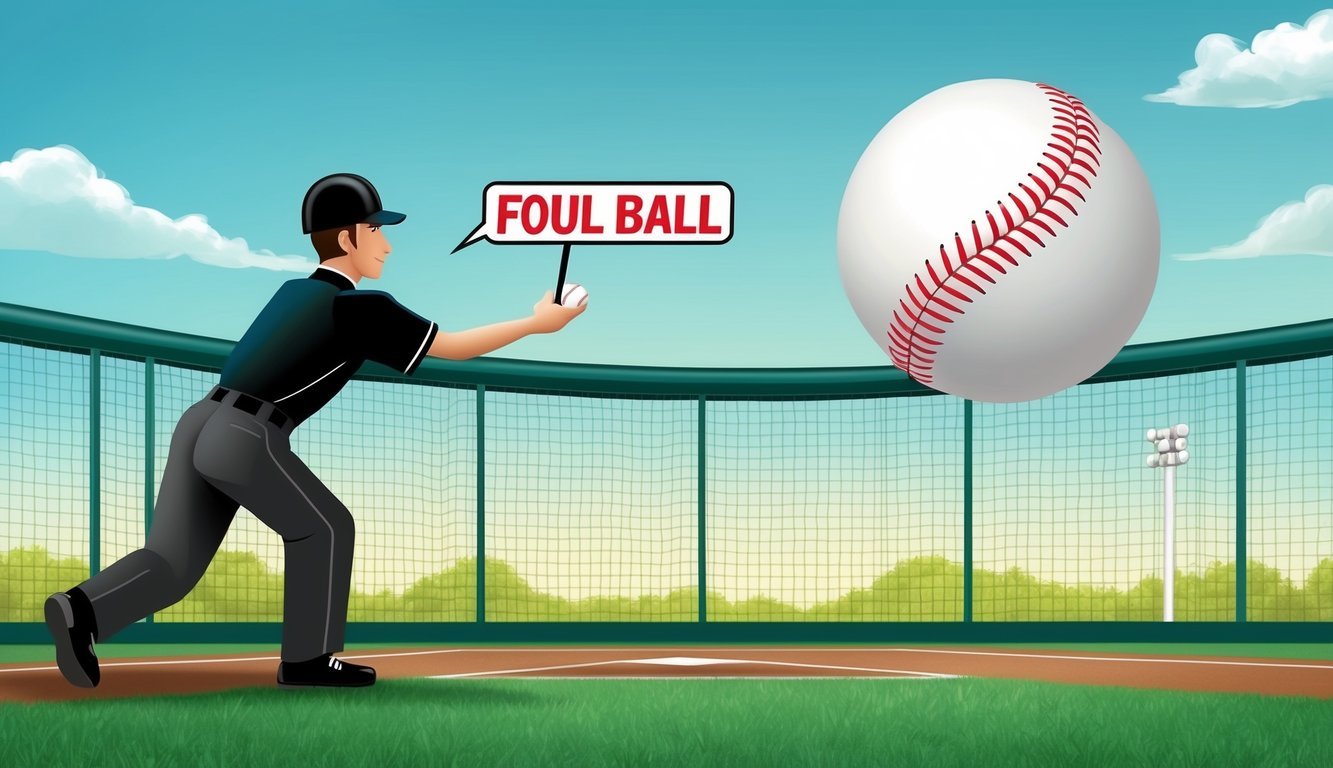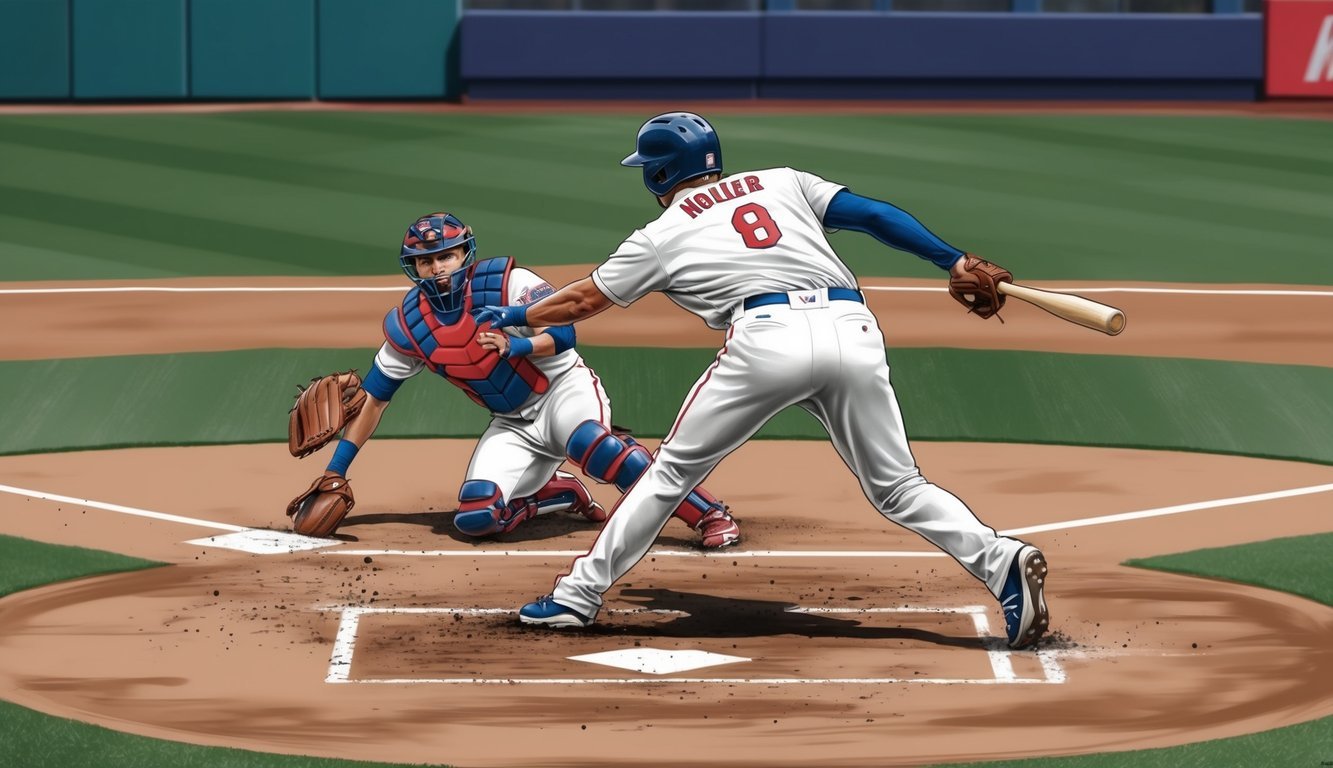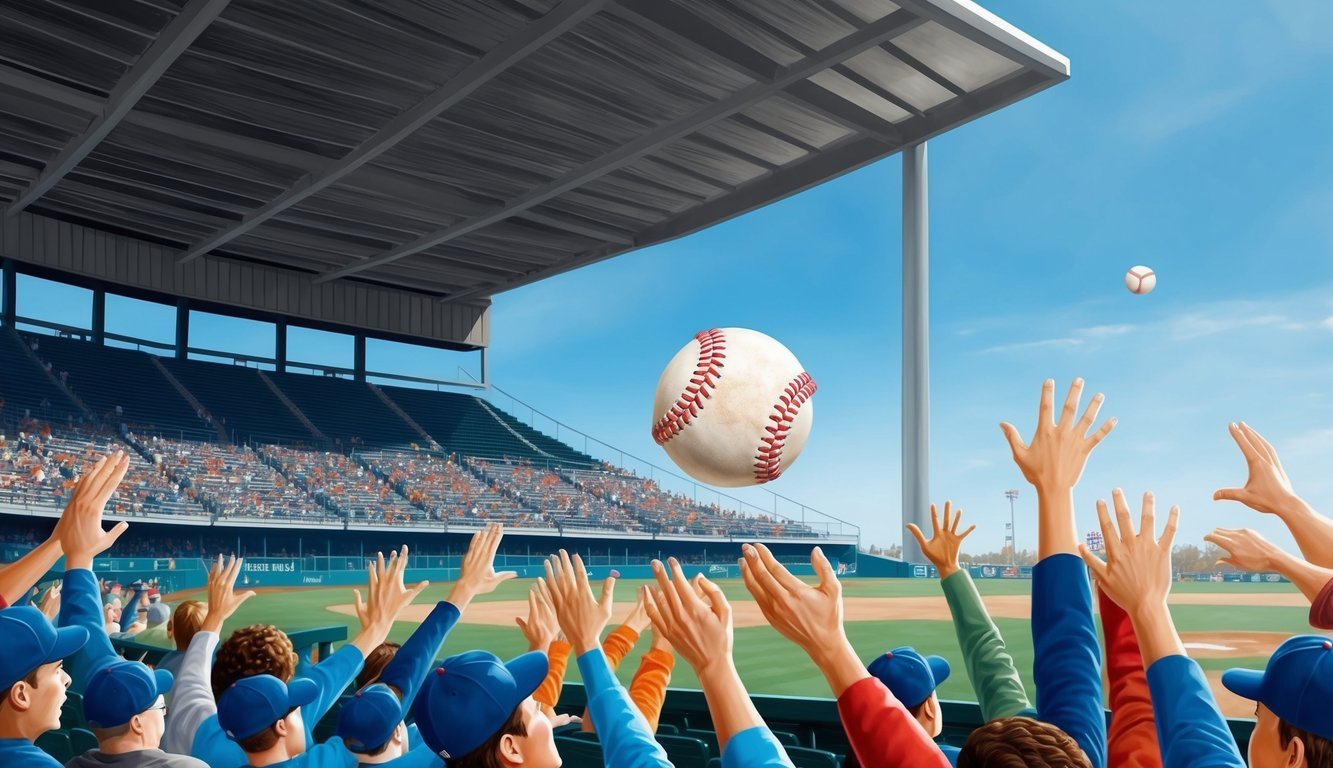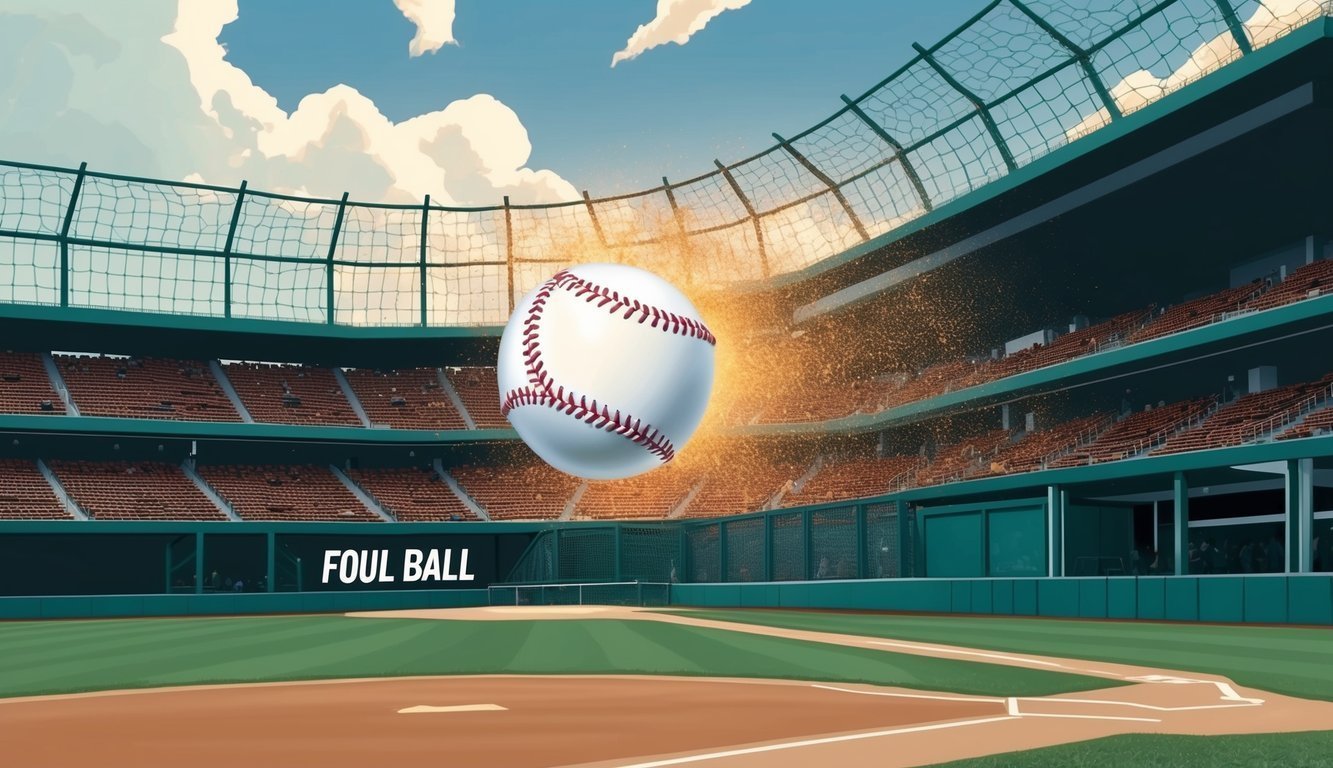Foul balls are a common sight in baseball, but they can often confuse casual fans. A foul ball is a batted ball that lands outside the fair territory and does not count as a hit. Understanding the rules behind foul balls is key to appreciating the game and can help fans follow the action more closely.
When players swing for the fences, sometimes their hits go awry, landing in foul territory instead.
This moment can shift the dynamics of an at-bat, affecting both the batter’s and pitcher’s strategies.
Knowing the difference between a foul ball, a fair ball, and other related terms can enhance the viewing experience and deepen a lover of the game’s connection to baseball lore.
Foul balls can also play a crucial role in the rhythm of the game, often leading to exciting moments during tense situations.
Whether it is a batter trying to achieve a perfect hit or a pitcher striving for a strikeout, foul balls add intrigue and strategy to every inning.
Key Takeaways
- A foul ball does not count as a hit in baseball.
- Foul balls can impact a game’s strategy and dynamics.
- Understanding foul balls enhances the overall baseball experience.
Basics of a Foul Ball
Foul balls are a key part of baseball, affecting the game’s strategy and outcome.
Understanding what counts as a foul ball involves knowing about foul territory and how it relates to fair balls on the field.
Defining Foul Territory
Foul territory is the area outside the foul lines that stretch from home plate to first and third base.
If a batted ball lands or is caught in this area before reaching the bases, it’s considered a foul ball.
This is true even if the ball is hit high or low.
The foul lines run from home plate to the outfield fence.
The foul poles mark the boundary where fair balls become foul when hit in the air.
If a ball hits the ground or a player in foul territory, it counts as a foul.
Foul balls play a significant role in a batter’s strategy.
Players often try to hit the ball just inside these lines for maximum benefit.
Relation to Fair Balls
The difference between a foul ball and a fair ball is crucial in baseball.
A fair ball is when the ball lands in the fair territory, which means it stays between the foul lines.
When a batter hits a ball that lands in fair territory, they can run the bases and attempt to score.
In contrast, a foul ball results in a strike against the batter unless they have two strikes already.
If a foul ball occurs with two strikes, the batter is allowed to keep hitting until they get a fair ball or miss the pitch.
This adds a layer of tension during at-bats, keeping players alert.
Understanding this relationship helps players and fans appreciate the nuances of the game.
The Role of the Foul Ball in Baseball
Foul balls are an essential part of baseball, impacting the game in various ways.
They can change a batter’s strategy, affect pitchers, and even influence base runners.
Understanding these aspects helps grasp the full dynamics of the game.
How Foul Balls Affect the Batter
For a batter, foul balls can be both a challenge and an advantage.
When a batter hits a foul ball, it counts as a strike unless they already have two strikes.
This adds pressure on the batter, as they need to avoid a third strike.
Foul balls can also help the batter gather information about the pitcher’s approach.
If a batter consistently fouls off pitches, they might be closer to finding one they can hit well.
Striking a balance between patience and aggression is key during an at-bat.
Implications for Pitchers and Fielders
Foul balls significantly impact pitchers as well.
When a batter fouls off pitches, it can lead to longer at-bats.
This may tire out pitchers more quickly and raise their pitch count, both of which decrease their effectiveness as the game goes on.
For fielders, foul balls shift their focus and positioning.
They often need to be quick to react in case a foul ball is hit near them, especially along the baselines.
Keeping alert to foul opportunities can create chances for outs and help maintain defensive momentum.
Foul Balls and the Base Runners
Foul balls also influence base runners.
When a foul ball is hit, runners generally stay close to their bases.
If a catcher catches a foul tip, any base runner must return to their original base before attempting to advance.
This strategic pause allows fielders to reset, and it emphasizes the importance of staying aware of the game situation.
Moreover, the rules governing foul balls are a testament to the history and traditions upheld by organizations like the National Association of Base Ball Players.
Understanding these nuances can be crucial for both players and coaches, as they navigate the complexities of the game.
The strategic timing of a foul ball can affect base running decisions.
Runners watch the batter’s count closely.
With two strikes, the risk of outs increases, and runners may hesitate before making aggressive moves.
This careful decision-making is vital in tight game situations.
Rules and Regulations

Foul ball rules are essential for understanding how the game is played.
They involve specific guidelines, the role of umpires, and unique situations that may arise.
Here’s an overview of the key aspects.
Understanding the Umpire’s Role
Umpires have a critical job when it comes to foul balls.
They make decisions based on the position of players and the ball’s location.
An umpire will rule a ball foul if it first contacts a fielder in foul territory.
If it touches the ground in foul territory beyond the bases, it’s also called foul.
Additionally, if a batted ball strikes the foul pole while in the air, it’s counted as a fair ball.
This can confuse newcomers, but the umpire’s call is final and essential for maintaining the game’s flow.
Specific Situations and Rulings
Certain scenarios clarify how foul balls are treated in baseball.
For example, if a player bunts the ball and it rolls into foul territory, the ball is ruled foul.
With a third strike caught in foul territory that is not a foul tip, the batter is out.
A foul tip that goes directly into the catcher’s glove is considered a strike, but the batter remains at the plate.
Knowing these specifics helps fans understand how umpires apply the rules.
Watching closely during games can provide better insight into these nuances.
Strategies and Playmaking

Successful baseball play involves careful planning both at bat and in the field.
Understanding how to create opportunities and defend against hitters can greatly influence the game’s outcome.
Here’s a look at offensive tactics and defensive perspectives.
Offensive Tactics
Batters often aim to exploit the rules surrounding foul balls.
When at the plate, they may use the strategy of trying to make contact with the ball, even when it leads to fouls.
This can disrupt the pitcher’s rhythm and create a chance for a more favorable pitch.
Players might focus on developing a keen eye, anticipating pitches, and adjusting their swings based on how the ball is being thrown.
Here are a few key offensive tactics:
- Make Adjustments: Batters can change their stance or swing to hit the ball in fair territory.
- Patience is Key: Waiting for the right pitch can lead to better hits rather than quick swings that result in foul balls.
- Follow the Count: Knowing the number of strikes can help a batter decide if they should risk swinging freely or play it safe.
These strategies help maintain pressure on pitchers and can result in scoring opportunities.
Defensive Perspectives
On the defensive side, teams must also account for how foul balls interact with gameplay.
Pitchers might aim to induce foul balls to keep hitters off balance.
By throwing pitches that are hard to reach or manipulate, they can create situations where batters struggle to make clean contact.
Key defensive strategies include:
- Pitch Selection: Using a mix of pitches can lead to more foul balls, increasing chances to strike out the batter.
- Positioning: Outfielders must be aware of where potential foul balls could land based on the hitter’s tendencies.
- Communication: Infielders and outfielders need to talk about who will catch a foul ball, ensuring they are on the same page.
Implementing these defensive tactics can effectively limit offensive scoring while maximizing team performance.
Frequently Asked Questions

Foul balls can lead to confusion, especially for those new to baseball.
Here are some specific questions and answers that clarify common misunderstandings about foul balls.
What’s the deal with catching a foul ball, like what happens next?
When a batter hits a foul ball, the ball is considered dead if it lands in foul territory.
If a player catches the foul ball before it hits the ground, it counts as an out.
The play then stops, and the batter returns to the plate.
Fans often try to catch foul balls, which can be exciting.
What exactly makes a ball foul or fair when it’s hit down the line?
A ball is fair if it lands inside the first or third base lines and does not roll outside these lines before reaching the outfield.
If the ball lands in foul territory, even if it is near the line, it is called a foul ball.
The placement of the ball at the moment it hits the ground is key.
Hey, can you strike out by hitting a foul ball or what?
A foul ball counts as a strike against the batter, but it cannot be the third strike that leads to a strikeout.
This rule allows batters to hit foul balls without the risk of losing their at-bat.
However, if a batter gets two strikes, hitting more foul balls can increase the tension of the at-bat.
What’s the big difference between a fly ball and one that’s foul?
A fly ball is a ball that is hit high into the air and can be caught by a fielder.
If it lands in fair territory, it counts as either a hit or an out.
A foul ball, on the other hand, is hit but lands in foul territory, making it dead and not eligible for play.
Are there any fresh changes to the MLB rules about foul balls?
As of now, there haven’t been any significant changes to the rules regarding foul balls in Major League Baseball.
The standard rules for counting strikes and determining fair or foul territory remain the same.
Any updates would typically be communicated before the start of a new season.
What’s up with touching a foul ball in play, like if it’s still fair territory?
If a player touches a foul ball while it is still in foul territory, it is considered a foul ball.
It doesn’t matter where the player is standing; if the ball lands in foul territory, it is foul.
Even if they touch the ball while their feet are in fair territory, the ruling is the same.
